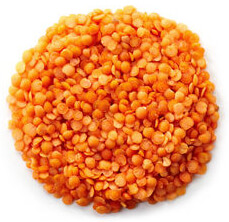The nutritional benefits of lentils is hardly news to anyone. A plant-based source of protein, fiber, and potassium, lentils make for a cheap and tasty dish that is packed with nutrition. Lentils are a one-size-fits-all term for an entire family of different varieties, though; and because of that, their nutritional contents can vary. In this article, we’ll be focusing on red lentil nutrition in particular and comparing them to various other types of lentils to see how they stack up.
In short, the hallmark of red lentil nutrition is that they contain more protein and potassium than most other types of lentils. However, they also contain the most calories and second-most carbohydrates. That said, these differences are minor as lentil varieties tend to share a similar nutritional profile.
Let’s elaborate on these details further.
Red Lentil Nutrition
Red lentils are not unlike other lentil varieties. Bright red in appearance, they tend to break down a little more easily and have a mushier texture as well. Additionally, they have a slightly sweeter taste than other types of lentils. The health benefits of lentils of all stripes are numerous, thanks to the nutritional punch they pack.

Nutrition Facts
Let’s have a look at how red lentil nutrition compares to that of various other types of lentils.
The table below compares the nutrition facts of a 1/4 cup serving of dry red lentils with a similar serving size of other varieties:
| Item | Red Lentils | Yellow Lentils | Green Lentils | French Green Lentils | Brown Lentils | Black Lentils |
| Serving Size | 1/4 cup, dry | 1/4 cup, dry | 1/4 cup, dry | 1/4 cup, dry | 1/4 cup, dry | 1/4 cup, dry |
| Calories | 190 | 169 | 170 | 160 | 180 | 145 |
| Total Carbohydrates | 33g | 30g | 31g | 29g | 34g | 25g |
| Sugar | 1g | 1g | 1g | 0g | 0g | 2g |
| Fiber | 7g | 5g | 8g | 14g | 9g | 10g |
| Total Fat | 0.5g | 0.5g | 1g | 0.5g | 0g | <1g |
| Saturated Fat | 0g | 0g | 0g | 0g | 0g | 0g |
| Protein | 12g | 12g | 11g | 10g | 11g | 12g |
| Sodium | 0mg | 3mg | 5mg | 0mg | 0mg | 3mg |
| Potassium | 500mg | 325mg | 430mg | 437mg | 550mg | N/A |
| Iron | 3mg | 3.12mg | 3.1mg | 4mg | 3mg | 4mg |
As evident in the data, red lentils aren’t too different from other lentils in terms of nutrition. Much like all other lentils, they’re an excellent source of protein, fiber, and potassium.
That said, there are a few minor pros and cons of opting for red lentils over other shades. Let’s elaborate a bit.
The Pros
Let’s have a look at some of the advantages you’ll enjoy when choosing the red variety of lentil.
Red Lentils Have Slightly More Protein Than Other Lentil Varieties
Possibly the biggest advantage that red lentils have over others is that they tie yellow and black lentils in terms of protein content.
Protein is an essential macronutrient that consists of amino acids and helps with tissue repair and building muscle.
Those following vegan, vegetarian, or other plant-based diets tend to struggle in reaching their daily protein goals as eliminating animal-based foods also eliminates some of the greatest sources of protein. This is why legumes, such as beans and lentils, are so important.
While all lentils are an excellent source of protein, red lentils have a slight edge over green, brown, and French green lentils, clocking in at 12 grams for every 1/4 cup serving.
They Contain More Potassium Too
Potassium is an essential electrolyte and mineral that’s crucial for managing fluid balance in the body, muscle contraction, electrical pulses, and maintaining healthy blood pressure. It’s also vital for keeping your body hydrated.
What’s more, potassium intake can also help lower blood pressure, according to the Harvard Health Publishing website.
While all varieties of lentils are a good source of potassium, red lentils take the cake. They have 500mg of potassium per 1/4 cup serving, compared to only 325mg in yellow lentils and 430mg in green lentils.
If you’re looking to increase your potassium intake, red lentils are a great option.
The Cons
Now that we’ve looked at some of the pros of what red lentil nutrition has to offer, let’s balance things out by taking a look at some of their potential drawbacks.
Red Lentils Have The Most Calories Of All Lentil Types
Possibly the biggest downside of choosing red lentils over some of the other shades is that they contain more calories than every other type surveyed.
Calories are the unit of measurement used to gauge energy intake and expenditure. It’s an important metric to monitor as it can help in managing body weight, according to Mayo Clinic.
This means that those seeking to lose weight will be at a disadvantage by choosing red lentils over the other options as they contain the most, clocking in at 190 per 1/4 cup serving– roughly 24% more than black lentils– the lentil we surveyed with the least calories.
Eating foods with a higher caloric density means that you’re consuming a smaller volume of food, which means they may not be as satiating as other foods.
They Also Have Slightly More Carbs
Those following a ketogenic (or “keto” diet) may be disappointed to hear that red lentils contain more carbohydrates than all other lentil types, with the exception of brown lentils.
While all varieties of lentils are relatively high in carbs, red lentils have the second-highest carb content, tied with yellow and green lentils.
If you’re looking to cut down on carbs or following a low-carb diet, opting for red lentils will put you at a slight disadvantage as they pack 33 grams of carbohydrates per 1/4 cup serving, which is second only to brown lentils.
That said, the difference here is minimal. Saving a few grams of carbs (per serving) may not be a worthy tradeoff when put into context with the rest of its nutritional profile.
The Bottom Line
In conclusion, the differences between red lentil nutrition vs that of other lentil types are minimal. Despite these modest differences, all lentils (red included) are packed with nutrition and have plenty of health benefits to offer.

